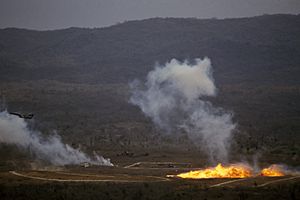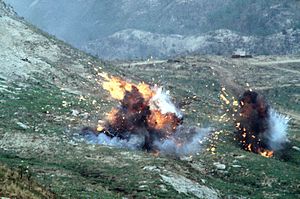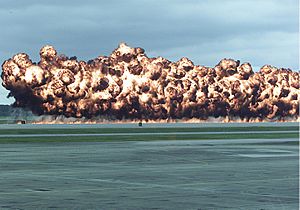Napalm facts for kids
Napalm is a special kind of liquid that burns easily. It has been used in wars. Think of it like jellied gasoline.
The word "napalm" actually refers to the thickener that makes the liquid sticky. When this thickener is mixed with gasoline, it creates a gel that burns very hot.
Scientists in the U.S. developed napalm during World War II. A team of chemists from Harvard University created it. Their leader was Louis Fieser. The name napalm comes from two of the first ingredients used: naphthenic and palmitic acids. These were added to make the flammable liquid into a gel.
Before napalm, other burning liquids were used in weapons like flamethrowers. But these liquids splashed and ran off too easily. Napalm solved this problem because it was sticky. It also allowed flamethrowers to shoot much farther.
Making these early burning gels used natural rubber, which was expensive. Napalm was a much cheaper and better solution.
Today, napalm is mostly made from benzene and polystyrene. This newer version is called napalm-B.
Napalm was used in flamethrowers and bombs by the U.S. and its Allied forces. It was designed to burn at a certain speed and stick to things. This made it very dangerous.
When used in bombs, napalm quickly removes oxygen from the air. It also creates a lot of carbon monoxide. This can cause people to suffocate. Napalm bombs were also used in the Vietnam War to clear areas for helicopters to land.
Even though napalm was invented in the 20th century, people have used burning materials in wars for a long time. For example, Greek fire was a famous burning liquid used in ancient times. The flamethrower weapon was first used in World War I by the Germans. Other countries soon made their own versions.
Contents
How Napalm Was Used in Wars
The first time napalm bombs were dropped was on July 17, 1944. American pilots dropped them on a fuel storage area in France during World War II.
Napalm bombs were also used in the Pacific during the Battle of Tinian. It was tricky to use at first because of problems with mixing and releasing the bombs.
During World War II, Allied forces bombed cities in Japan with napalm. They also used it in Germany and on Japanese-held islands.
After World War II, napalm was used in other conflicts. The Greek army used it against communist fighters. United Nations forces used it in the Korean War. Mexico used it in the 1960s. The United States used it a lot during the Vietnam War.
The most common way napalm was used was in bombs dropped from planes. But it was also used in flamethrowers by soldiers on the ground. These flamethrowers used a thinner version of the jellied gasoline. They were used to destroy enemy positions like bunkers and cave hideouts.
U.S. Marines fighting on Guadalcanal found flamethrowers very effective. Fire was used to cause harm and also to scare the enemy. Soldiers have a natural fear of fire. Japanese soldiers would sometimes leave their positions when faced with napalm, even if they fought to the death against other weapons. Prisoners of war later said they feared napalm more than any other weapon.
Napalm became a very important weapon in the Korean War. Pilots often said they preferred dropping napalm over other weapons like bombs or rockets. The U.S. Air Force and Navy used napalm against many targets, including troops, tanks, buildings, and even railroad tunnels.
Napalm had a strong effect on enemy morale. Many North Korean troops started surrendering to planes flying overhead after napalm was dropped. Pilots saw enemy soldiers waving white flags. They radioed ground troops, and the North Koreans were captured.
Napalm has been used in more recent conflicts by or against countries like Iran, Israel, Nigeria, Brazil, Egypt, Cyprus, Argentina, Iraq, Serbia, Turkey, Angola, and the United States.
Napalm can cause very severe burns. Some victims suffer burns that damage parts of the skin where there are no pain nerves. However, even less severe burns from napalm can cause a lot of pain.
Phan Thị Kim Phúc, a survivor of a napalm bombing in Vietnam, described the pain. She said, "Napalm is the most terrible pain you can imagine." She explained that water boils at 100 degrees Celsius, but napalm burns at 800 to 1,200 degrees Celsius.
Kim Phúc had very serious burns on half of her body. Doctors did not expect her to live. But with help from photographer Nick Ut, she survived a long hospital stay and many operations. She later became a peace activist.
International Rules for Napalm

International law does not completely ban the use of napalm against military targets. However, using it against civilians was banned by the United Nations in 1981. This ban is part of the inhumane weapons convention (called the CCW).
Protocol III of the CCW limits the use of burning weapons, including napalm. But not all countries have agreed to all parts of this convention. For example, the United States is part of the CCW but did not sign Protocol III.
Reports suggested that napalm was used by U.S. forces in the Iraq War. The U.S. Department of Defense said this was not true. However, in August 2003, a newspaper called the San Diego Union Tribune reported that U.S. Marine pilots confirmed using Mark 77 firebombs at the start of the fighting.
Official denials about "napalm" were a bit tricky. The Mk 77 bomb used then, the Mk 77 Mod 5, did not use the exact chemical mixture of napalm (like napalm-B). The last U.S. bomb that used actual napalm was destroyed in 2001.
The substance used now is a different burning mixture. But its effects are very similar to napalm. So, people still sometimes call it "napalm."
One colonel said in an interview, "We napalmed both those (bridge) approaches." He added, "Unfortunately, there were people there because you could see them in the (cockpit) video." He also said, "They were Iraqi soldiers there. It's no great way to die." He noted that generals liked napalm because "It has a big psychological effect."
These bombs used in the Gulf War did not contain the same gasoline-based napalm-B from Vietnam. Instead, they used a kerosene-based liquid. But it still had a similar burning effect to napalm.
What Napalm is Made Of

Napalm is usually a mix of gasoline and special thickening agents. These agents make the gasoline into a sticky gel.
Other pages
Images for kids
-
Results of a napalm strike by the Aviation navale on suspected Viet Minh positions during the First Indochina War, December 1953
See also
 In Spanish: Napalm para niños
In Spanish: Napalm para niños





